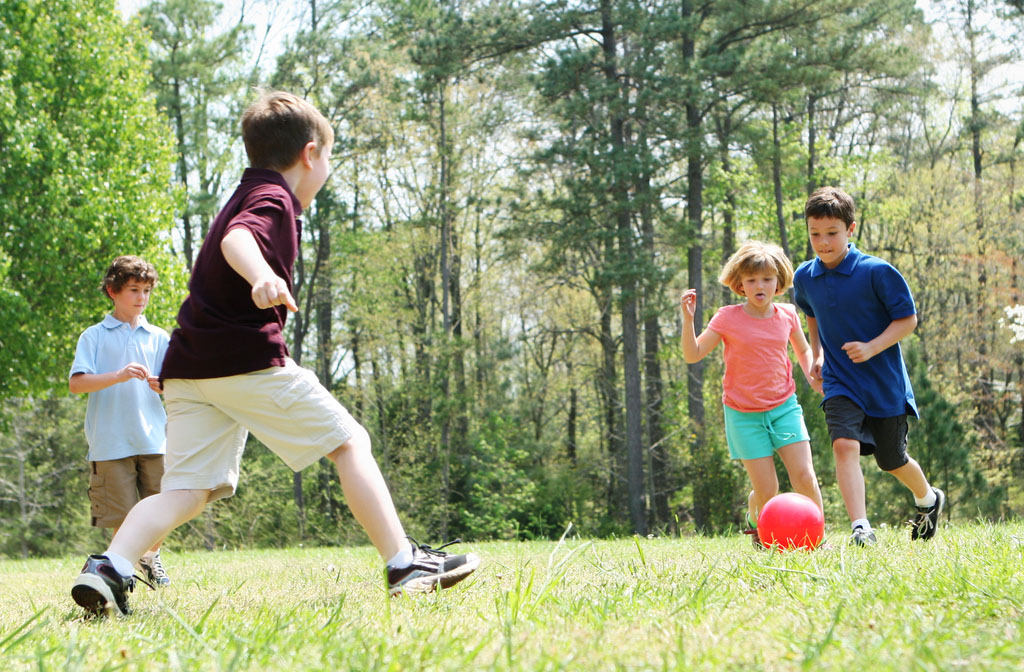Written by Debra Kellstedt, DrPH, Assistant Professor and Extension Specialist, Texas A&M AgriLife Extension Service
How did you spend your time as a child? Were you one of those “free range” kids who was outside from dawn until dusk climbing trees, skipping rocks, and building forts? The way children currently spend their time is very different from the way children of past generations whiled away their days. Much of children’s activity these days takes place inside and under adult supervision (Hofferth & Sandberg, 2001). This shift in the way children spend their time could be harming their health.
Lost Connection to Nature & its Impact on Health & Well-being
We know that childhood obesity rates are on the rise (Stierman et al., 2021), and, certainly, since the pandemic, mental health issues like anxiety and depression are becoming more prevalent among children (Collishaw, 2015; Marques de Miranda, da Silva Athanasio, Sena Oliveira, & Simoes-E-Silva, 2020). How and where children spend their time may influence these problems. Richard Louv in his bestselling book Last Child in the Woods argues that we all have an innate need to be outside—fully immersed, with all five senses—in nature regularly (Louv, 2008). He describes how current generations of children have lost their connections to nature—important life-enhancing connections. He calls this a “nature deficit disorder (Louv, 2008).” Instead of taking in all the sights, smells, and sounds of nature, along with the resulting excitement and awe, children are absorbed in and are often overwhelmed by, information on screens. Children today spend an average of seven hours a day on tablets, monitors, and cell phones (Rideout, Foehr, & Roberts, 2010).
Often when we are engaged with screens, we are inactive, inside, and completely isolated—all of which can lead to negative health outcomes. In contrast, spending regular time outside has been shown to provide all kinds of benefits to children that can lead to greater health and wellness. These benefits include reduced symptoms of ADHD, improved test scores, greater attention to detail, increased physical activity, higher self-esteem, and lower rates of depression, to name a few (Chawla, 2015). In the past ten years, there has been a large body of research finding a significant health and nature connection (Hartig, Mitchell, de Vries, & Frumkin, 2014).
Fostering Outdoor Engagement
With the growing recognition of the importance of time in nature for children, there are efforts in many settings to get them outside. In early childhood education, educators are moving more to learning outside and providing environments that encourage nature play. In elementary school, gardening has been incorporated into the curriculum, and recess is again recognized as an important part of the school day. Programs have been developed by state and national parks and other organizations that bring children into more “wild” nature with activities like camping and hiking. We see profound benefits from these types of experiences for children of all ages and abilities including children with disabilities (McAvoy, 2001).
Nurturing all children by helping them to spend regular time playing outside and providing them with skill-building experiences in nature will give them joy and confidence that leads to greater health and happiness in the long run.
References
Chawla, L. (2015). Benefits of Nature Contact for Children. Journal of planning literature, 30(4), 433–452. https://doi.org/10.1177/0885412215595441
Collishaw, S. (2015). Annual research review: Secular trends in child and adolescent mental health. Journal of Child Psychology and Psychiatry, and Allied Disciplines, 56(3), 370–393. https://doi.org/10.1111/jcpp.12372
Hartig, T., Mitchell, R., de Vries, S., & Frumkin, H. (2014). Nature and health. Annual review of public health, 35(35), 207–228. https://doi.org/10.1146/annurev-publhealth-032013-182443
Hofferth, S. L., & Sandberg, J. F. (2001). How American children spend their time. Journal of Marriage and Family, 63(2), 295–308. https://doi.org/10.1111/j.1741-3737.2001.00295.x
Louv, R. (2008). Last Child in the Woods: Saving our children from nature-deficit disorder. Algonquin books.
Marques de Miranda, D., da Silva Athanasio, B., Sena Oliveira, A. C., & Simoes-E-Silva, A. C. (2020). How is COVID-19 pandemic impacting mental health of children and adolescents? International journal of disaster risk reduction : IJDRR, 51, 101845. https://doi.org/10.1016/j.ijdrr.2020.101845
McAvoy, L. (2001). Outdoors for Everyone: Opportunities that Include People with Disabilities. Parks & Recreation, 36(8).
Rideout, V. J., Foehr, U. G., & Roberts, D. F. (2010). Generation M 2: Media in the Lives of 8-to 18-Year-Olds. Henry J. Kaiser Family Foundation.
Stierman, B., Afful, J., Carroll, M. D., Chen, T. C., Davy, O., Fink, S., … Ostchega, Y. (2021). National health and nutrition examination survey 2017–March 2020 prepandemic data files development of files and prevalence estimates for selected health outcomes.
*Image Source: iStockphoto, kirin_photo















